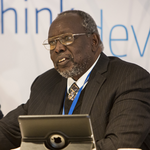Blog
Common factors in conflict-induced state fragility
What does it mean to be a fragile state? According to the IMF, fragile states are those in ‘which the government is unable to reliably deliver basic public services to the population – [they] face severe and entrenched obstacles to economic and human development.’ It is with this understanding that I have identified nine common factors at play in political and economic transitions. These are, in my view, drivers and symptoms of state fragility.
The root causes of conflict-induced state fragility can be considered primary common factors. Leadership is the foundation of a just, egalitarian and harmonious society, and by extension, the state. In this regard, conflict-induced fragility is a function of weak leadership (factor 1), which in turn precipitates the other root causes: injustice, inequality, and ethnic tensions (factors 2, 3, and 4). The secondary common factors listed below are symptoms of state fragility.
| Primary common factors: | Secondary common factors: |
|---|---|
|
1. weak leadership 2. injustice 3. inequality 4. ethnic tensions |
5. violence dimension 6. justice for all dimension 7. institutions dimension 8. economic foundations dimension 9. capacity to adapt to shocks |
South Sudan: a case study
I would argue that the new country of South Sudan was born after a protracted war of liberation with the nine common factors at play. But the leaders of the liberation struggle and their supporters in the international community didn’t pay attention to these factors — paving the way for continued struggles.
Weak leadership created feelings of injustice and inequality, leading to ethnic tensions
Conflict-induced fragility is a function of weak leadership, which in turn precipitates the other root causes: injustice, inequality, and ethnic tensions.
In fact, the liberators quickly became the looters of income and wealth of their new nation, evidenced by a recent report. They would make up, in this sense, weak leadership (factor 1); their kleptocratic behaviour fuelled feelings of injustice and inequality (factors 2 and 3) among the population. Ethnic-based injustice (real or perceived) is seen by many analysts to have created unequal opportunities (inequality) between the various ethnic groups in South Sudan. That is, the Dinka ethnic group is perceived by other ethnicities to be dominating access to resources, power and wealth creation opportunities. This created ethnic tensions (factor 4), seen in the response of those who strongly feel excluded (e.g. those of Nuer ethnicity) — resistance by all means available.
Circle of fragility or fragility trap
These drivers have deepened the fragility of the South Sudanese state, creating a vicious circle of fragility that is difficult to break. This is especially true where there is a knowledge gap on how the drivers and dimensions of fragility interact and reinforce each other. Ethnic tensions in an environment of weak institutions of justice, accountability, inclusiveness, responsibility, and openness (JAIRO) — combined with a weak capacity of the state to respond to shocks — resulted in violent conflict on 15 December 2013 and 8 July 2016, just under three months after the formation of Transitional Government of National Unity (TGoNU).
Over the period 2005-13 the country was in the hands of groups engaged in violent conflict with one another and who were dividing the country along ethnic lines. During this time, nothing tangible was done to:
a) improve devastated social and economic infrastructures
b) settle communal disputes over land and access to resources
c) resettle and integrate returning populations, and
d) provide basic services to the population.
During this time, the leaders in violent conflict stood back and let international partners do all the work of providing the few basic services available, such as health and education, while angling to divert oil revenues. In a presentation in Juba, South Sudan on 13 February 2014, Joel Hellman of the World Bank stated, ‘If countries experience repeated cycles of poor governance, low investment, new stresses and violent relapses, they can remain stuck in a fragility trap.’ According to this, South Sudan is stuck in a fragility trap.
In my next blog post, I will further discuss the notion of a fragility trap and the events that have kept South Sudan in this position in recent years.
Lual A Deng is the Managing Director and founder of the Juba-based Ebony Center for Strategic Studies (ECSS).
The views expressed in this piece are those of the author(s), and do not necessarily reflect the views of the Institute or the United Nations University, nor the programme/project donors.
 Join the network
Join the network





